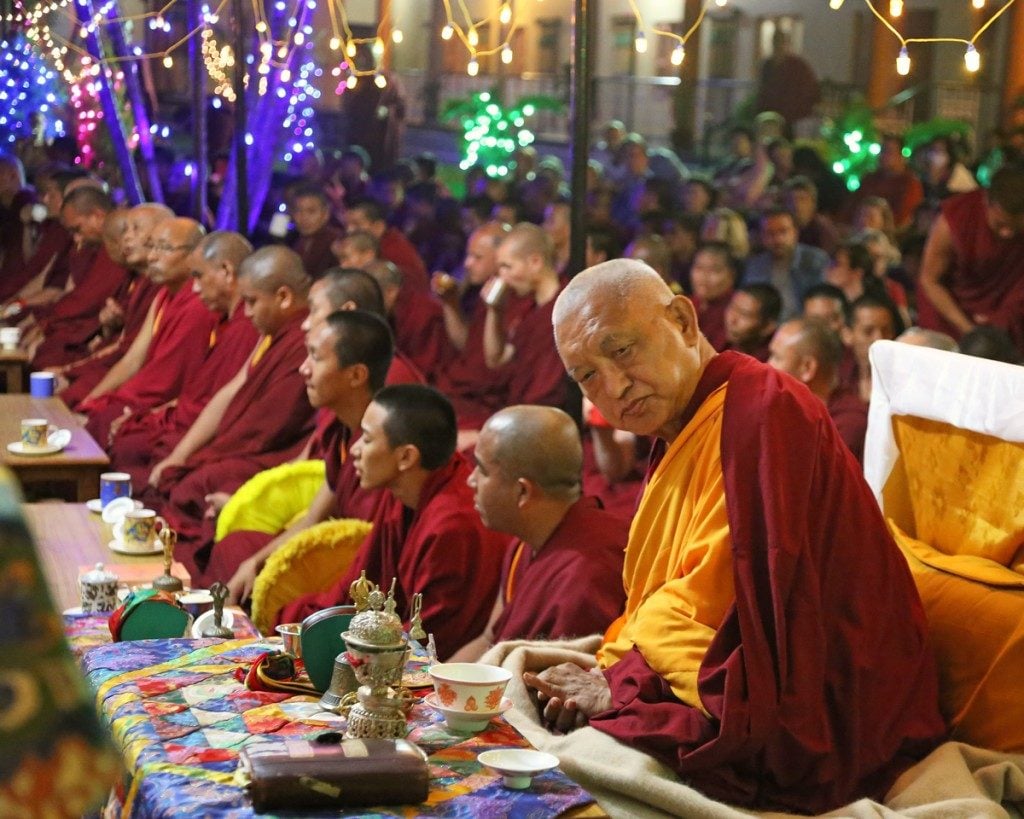Dakini Day, celebrated on the 25th day of each lunar month in Vajrayana Buddhist traditions, celebrates the feminine energy of wisdom. Dakini Day and Tsog on the 25th of the Lunar Month: January 6 February 5 March 5 April...
Dakini Day, celebrated on the 25th day of each lunar month in Vajrayana Buddhist traditions, celebrates the feminine energy of wisdom.

Dakini Day and Tsog on the 25th of the Lunar Month:
January 6 February 5 March 5 April 4 May 3 July 1 and July 30 August 28 September 27 October 26 November 25 December 25About Tsog or Tsok Offering
Devoted Buddhists will celebrate with a Tsok (Tsog), a feast including food, singing, a group (or single) sadhana full of sound and celebration. The 10th is also celebrated with Daka Tsog to honor Guru Rinpoche and the Heroes (Dakas). Tsog is normally a commitment in higher yogic practices.
For a full story on “What is Tsog” see this feature>>
Dakinis are portrayed as elusive, playful and often fierce and naked to symbolically convey how elusive true Wisdom encompassing “Emptiness” can be.
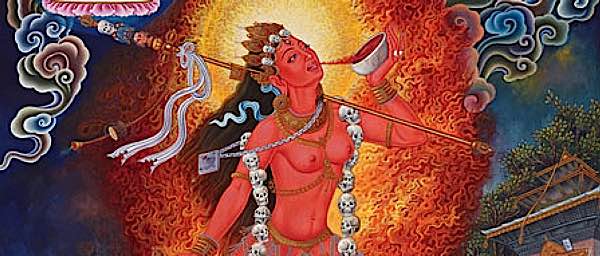
Dakinis: Protective, Mother, Activity, Wisdom
Without contradiction to their role as exemplars of Emptiness, Dakinis can also represent fierce activities (Lion-Faced Dakini, aspects of Tara), and protection (Green Tara and Palden Lhamo) — the ferocious protective love of a mother [For a story on Palden Lhamo, the female protector, view here>>]. Most Tibetan Buddhist temples and meditation centres try to arrange a monthly Tsog on this day each month, with celebrants bringing food as offerings. It is always a happy day, that invites blessings not only for the attendees, but for all sentient beings.
Padmasambhava described Dakinis as “the bestower of excellent blessings.” [3]
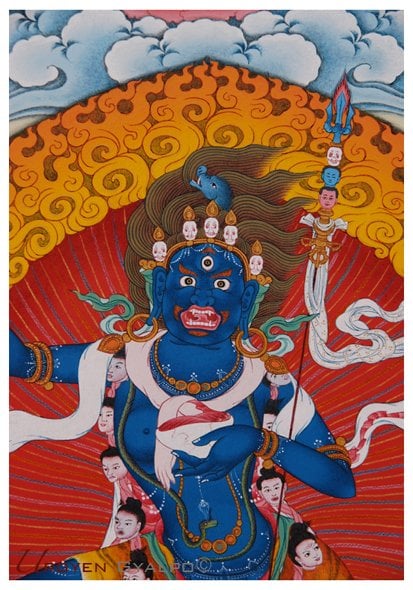 Black Troma Nagmo Lion Faced Dakini. Wrathful Dakinis represent “active” Female wisdom. For more on the “psychology Wrathful deities see>>
Black Troma Nagmo Lion Faced Dakini. Wrathful Dakinis represent “active” Female wisdom. For more on the “psychology Wrathful deities see>>
What is a Dakini?
The Dakini represents the divine feminine. (Khandroma in Tibetan, K’ung-hsing fo-mu in Chinese.) Dakini practices focus on Enlightened Feminine (although there are also some “unenlightened Dakinis”) — the Enlightened Dakinis such as Vajrayogini or Vajravarahi and, of course, Tara in all her forms. Dakini can also refer to female sangha, teachers and students who might be exemplars of the path.
In Buddhism, typically, the male Buddhas represent compassionate means, epitomized in Avaolokiteshvara (Chenrezig), while the female Buddhas represent Wisdom, typically exemplified in Tara or Vajrayogini. The symbols of bell and vajra (Ghanta and Dorje) represent female wisdom — the bell, which makes the sound of “Emptiness” — and the Vajra, representing compassionate means.
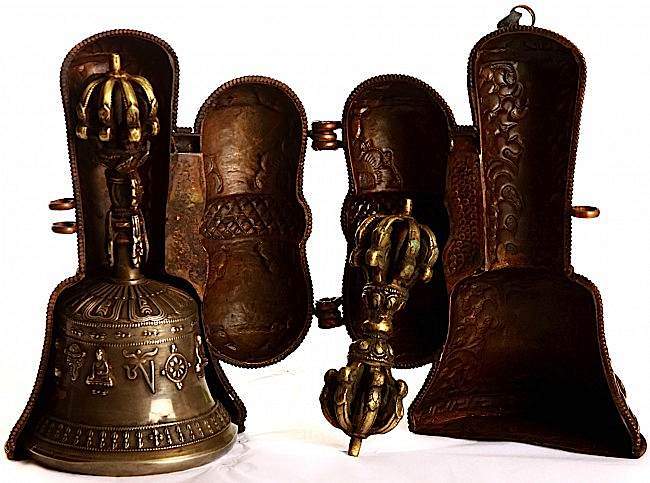 The bell, on the left, represents Enlightened Feminine Wisdom while the Vajra (right) represents “Male” Compassionate Means.
The bell, on the left, represents Enlightened Feminine Wisdom while the Vajra (right) represents “Male” Compassionate Means.
The Dakini is almost always an advanced practice, or Highest Yoga Tantra, largely because their practice explores the challenging notion of “Emptiness” (not be be confused with Nothingness. (For an article on Emptiness, see>>)
Padmasambhava, the great Eight Century Enlightened Yogi of Tibet, “reasoned that women are better equipped to realize the wisdom of the teachings…” [1]
Playful, Naked and Elusive
Just as true wisdom is “elusive”, the female enlightened, in the form of Dakinis, is very “elusive and playful.” [1] Dakinis recognize that true wisdom does not come from intellectual debate and meditative contemplation alone. The elusive wisdom of Dakinis is the ultimate wisdom of Emptiness.
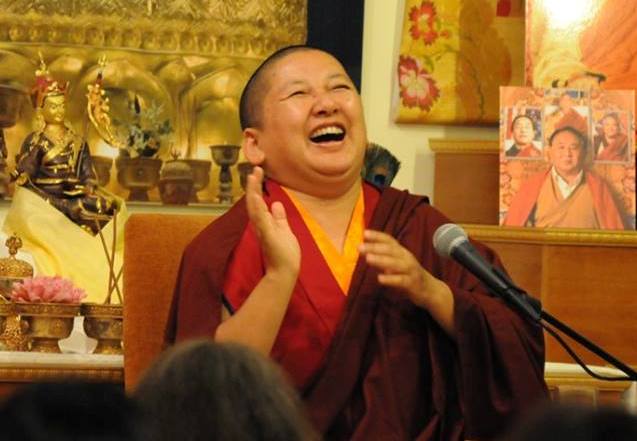 Khandro Rinpoche.
Khandro Rinpoche.
Khandro Rinpoche defines the authentic dakini principle as “a very sharp, brilliant wisdom mind that is uncompromising, honest, with a little bit of wrath.” [1]
Dakini’s have always been a part of Buddhism, starting with the Jataka’s (stories of Buddha’s former lives) in which “divine beings are described as travelling through the air. In Sanskrit, such a being is called a dakini, a term generally translated as “space-goer,” “celestial woman,” or “cloud fairy.”” [2]
Dakinis are typically thought of as the emanation of the “Enlightened Mind” understanding Emptiness. Another concept usually tied to Dakini practice is “bliss” — the state of blissful awareness of emptiness.
It is a wonderful experience to have a moment that realizes emptiness, a feeling of joy-bliss rather than “nothingness.” This is why Dakinis are often portrayed as active, dancing, joyful or fierce, naked and unencumbered.
There are also male aspects, called Dakas. Typically, the 25th day of the lunar month is focused on Dakinis, while the 10th day of the lunar month (which is also a Tsok feast day) is for the Dakas — and also to celebrate Guru Rinpoche Day.
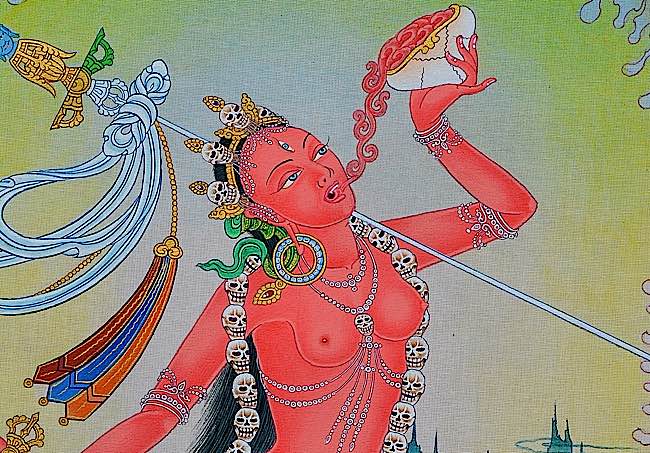 Vajrayogini (and Vajravarahi) is the “highest” manifestation of Dakini Wisdom. Here she is symbolically naked (freedom of wisdom), drinking nectar, with the male Heruka (compassion) khatanga on her shoulder. She dances to demonstrate the joy of realization and the activity of Dakinis. The skulls represent concepts such as impermanence. Red indicates magnetizing influence — and also the “speech” of the Buddha (Typically Body is white, Speech red, Mind blue). Vajrayogini, representing “wisdom of emptiness” can be practiced/portrayed/ visualized in union with compassion in the form of many Herukas, such as Chakrasamvara or the great Hayagriva (fierce manifestation of Chenrezig or Avalokiteshvara).
Vajrayogini (and Vajravarahi) is the “highest” manifestation of Dakini Wisdom. Here she is symbolically naked (freedom of wisdom), drinking nectar, with the male Heruka (compassion) khatanga on her shoulder. She dances to demonstrate the joy of realization and the activity of Dakinis. The skulls represent concepts such as impermanence. Red indicates magnetizing influence — and also the “speech” of the Buddha (Typically Body is white, Speech red, Mind blue). Vajrayogini, representing “wisdom of emptiness” can be practiced/portrayed/ visualized in union with compassion in the form of many Herukas, such as Chakrasamvara or the great Hayagriva (fierce manifestation of Chenrezig or Avalokiteshvara).
The Wisdom of Enlightenment
Wisdom, without Compassion, is not the path to Enlightenment, which is why, in Tantric Buddhism, Dakinis are often in union with male Herukas (Buddhas) — this symbolically demonstrates the union of Wisdom (Dakini) and Compassion (Heruka or “Hero”). This is symbolic, not literal — in other words not a sexual representation. It’s symbolically conveys you cannot have one without the other (wisdom without compassion, or compassion without wisdom) if your goal is to achieve Enlightenment for the benefit of all sentient beings. Also, that the union of wisdom and compassion bring bliss.
Nyingma master, Chagdud Tulku, explained, “Dakini refers to the feminine principle of wisdom that manifests in female form to benefit beings. We say the lama’s mind is the dakini because it embodies the inseparability of emptiness and wisdom, the absolute dakini. This absolute nature, dharmakaya, manifests as the subtle display of the samboghakaya dakini and the nirmanakhaya, or physical form of great female realization holders in order to benefit beings.” [2]
Dakini Power book:
Dakinis can come in many forms, but are normally portrayed as active, playful and fierce. The notable exeptions are the many manifestations of Tara [Read more about Green Tara here>>]. Most enlightened Dakinis can be thought of as emanations of Tara — at the level of ultimate reality. Tara herself, in her many forms, can be thought of as a Dakini:
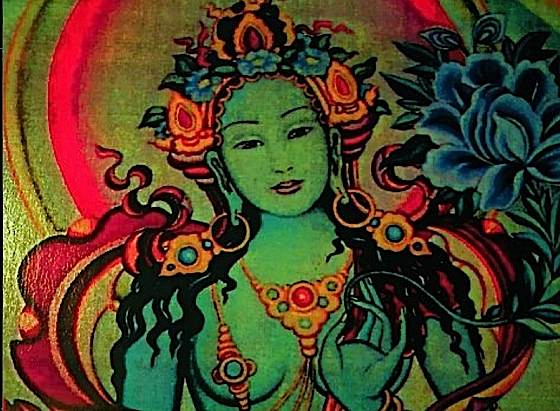 Tara, the most beloved of Female Buddhist Enlightened deities, represents wisdom in action.
Tara, the most beloved of Female Buddhist Enlightened deities, represents wisdom in action.
The Four Classes the Four Empowerments
Padmasambhava taught there were “four classes of Dakinis, who are the Daknis of the four families of Vajra, Ratna, Padma, and Karma. They art spiritual beings who carry out the four activities of pacifying, increasing, magnetizing and subjugating.” Dakinis often are also visualized in advanced practices as giving the four empowerments: “the empowerments of vase, secret, wisdom knowledge and precious word.” [3]
Dakinis are also strongly associated with the great Mahasiddhas of India, particularly Vajrayogini. It is often said that all of the Mahasiddas relied on Dakinis. Also, most of the great Enlightened Yogis and Yoginis of India and Tibet practiced Dakinis.
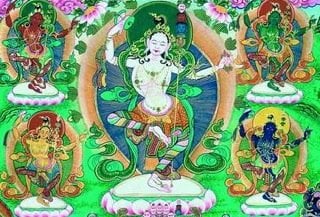 Dakinis and wrathful deities are important higher tantra practices in Vajrayana, and are the most likely to be misunderstood due to the symbolism.
Dakinis and wrathful deities are important higher tantra practices in Vajrayana, and are the most likely to be misunderstood due to the symbolism.
Practicing Dakinis
There are, it is said, countless emanations of wisdom, although at the ultimate level, they are all one. Probably the best known Dakini is Vajrayogini. These practices do require a teacher and initiation, due to their profundity, but many Buddhists around the world attend Tsog (as spectators and to receive blessings) and Dakini public pujas as a blessing. Padmasambhava described the Dakini as the “bestower of excellent blessings.” [3].
Dakini mantras should not be recited without appropriate teachings and intimations, although many people will get started on the path to feminine wisdom with the practices and mantras of Tara, which do not require initiation:
Om Tare Tuttare Ture Svaha
In addition, some Buddhists who may not yet have initiation, might set up a statue or tangkha of a Dakini, especially Vajrayogini, and present offerings. A student does not have to be initiated to honour the wisdom of Enlightenment. Initiation is a step towards realizing that Emptiness. But the precursor to that is often doing the things that Dakini’s delight in:
Making offerings to all the Buddhas, Yidams and Dakinis, especially water offerings (a BW story on water offerings)>> Keeping vows and samaya with one’s teacher Taking Refuge in Guru, Buddha, Dharma Sangha (Guru and Three Precious Jewels.) Lamrim and foundation practices (a video on foundation and Lamrim practices here>>) Practice mindfulness and metta (loving kindness) meditation. Meditation is the path to wisdom. (Story on the ten benefits of Metta Loving Kindness Meditation here>>) Keep up your daily meditations and practice, and dedicate a little time to the contemplation of emptiness.It is said that you do not have to call to Dakinis. Because we all have Buddha Nature, we all have Dakini within. Dakinis manifest spontaneously in our lives when we perform pleasing acts of compassion, conduct ourselves ethically, and follow the precepts.
Om Ah Hum.
NOTES
[3] Page 24 in “Dakini Teachings”







